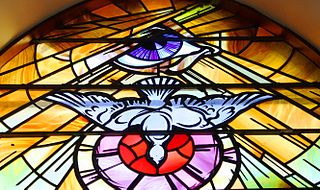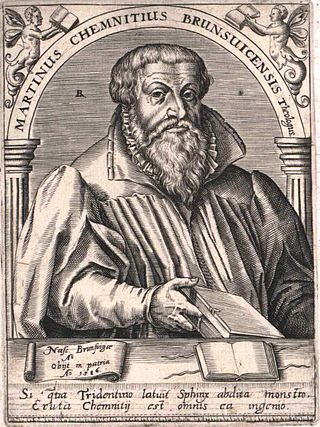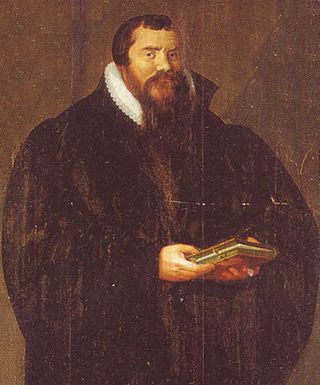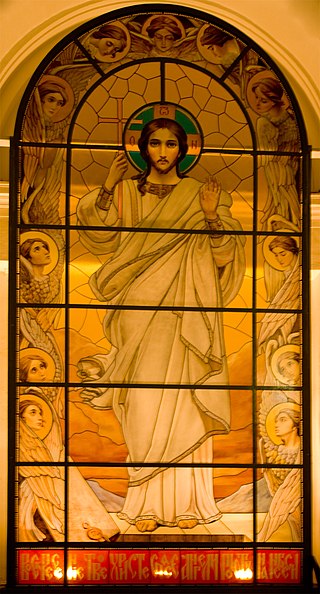
In Christianity, Christology, translated from Greek as 'the study of Christ', is a branch of theology that concerns Jesus. Different denominations have different opinions on questions such as whether Jesus was human, divine, or both, and as a messiah what his role would be in the freeing of the Jewish people from foreign rulers or in the prophesied Kingdom of God, and in the salvation from what would otherwise be the consequences of sin.
Incarnation literally means embodied in flesh or taking on flesh. It refers to the conception and the embodiment of a deity or spirit in some earthly form or the appearance of a god as a human. If capitalized, it is the union of divinity with humanity in Jesus Christ. In its religious context the word is used to mean a god, deity, or divine being in human or animal form on Earth.

Omnipresence or ubiquity is the property of being present anywhere and everywhere. The term omnipresence is most often used in a religious context as an attribute of a deity or supreme being, while the term ubiquity is generally used to describe something "existing or being everywhere at the same time, constantly encountered, widespread, common". Ubiquitous can also be used as a synonym for words like worldwide, universal, global, pervasive, all over the place.
In Christian theology, divinization, or theopoesis or theosis, is the transforming effect of divine grace, the spirit of God, or the atonement of Christ. Although it literally means to become divine, or to become God, most modern Christian denominations do not interpret the doctrine as implying an overcoming of a fundamental ontological difference between God and humanity; for example, John of the Cross indicated that while "God communicates to it [the individual soul] His supernatural Being, in such wise that it appears to be God Himself, and has all that God Himself has", yet "it is true that its natural being, though thus transformed, is as distinct from the Being of God as it was before".

Jakob Böhme was a German philosopher, Christian mystic, and Lutheran Protestant theologian. He was considered an original thinker by many of his contemporaries within the Lutheran tradition, and his first book, commonly known as Aurora, caused a great scandal. In contemporary English, his name may be spelled Jacob Boehme ; in seventeenth-century England it was also spelled Behmen, approximating the contemporary English pronunciation of the German Böhme.

In Christian theology, kenosis is the 'self-emptying' of Jesus. The word ἐκένωσεν is used in the Epistle to the Philippians : "[Jesus] made himself nothing" (NIV), or "[he] emptied himself" (NRSV), using the verb form κενόω, meaning "to empty".
Communicatio idiomatum is a Christological concept about the interaction of deity and humanity in the person of Jesus Christ. It maintains that in view of the unity of Christ's person, his human and divine attributes and experiences might properly be referred to his other nature so that the theologian may speak of "the suffering of God".

Martin Chemnitz was an eminent second-generation German, Evangelical Lutheran, Christian theologian, and a Protestant reformer, churchman, and confessor. In the Evangelical Lutheran tradition he is known as Alter Martinus, the "Second Martin": Si Martinus non fuisset, Martinus vix stetisset goes a common saying concerning him. He is listed and remembered in the Calendar of Saints and Commemorations in the Liturgical Church Year as a pastor and confessor by both the Evangelical Lutheran Church in America and Lutheran Church–Missouri Synod.

Girolamo Zanchi was an Italian Protestant Reformation clergyman and educator who influenced the development of Reformed theology during the years following John Calvin's death.

The threefold office of Jesus Christ is a Christian doctrine based upon the teachings of the Old Testament of which Christians hold different views. It was described by Eusebius and more fully developed by John Calvin.
The Ubiquitarians, also called Ubiquists, were a Protestant sect that held that the body of Christ was everywhere, including the Eucharist. The sect was started at the Lutheran synod of Stuttgart, 19 December 1559, by Johannes Brenz (1499–1570), a Swabian. Its profession, made under the name of Duke Christopher of Württemberg and entitled the "Württemberg Confession," was sent to the Council of Trent in 1552, but had not been formally accepted as the Ubiquitarian creed until the synod at Stuttgart.

In Protestant Christianity, the relationship between Law and Gospel—God's Law and the Gospel of Jesus Christ—is a major topic in Lutheran and Reformed theology. In these religious traditions, the distinction between the doctrines of Law, which demands obedience to God's ethical will, and Gospel, which promises the forgiveness of sins in light of the person and work of Jesus Christ, is critical. Ministers use it as a hermeneutical principle of biblical interpretation and as a guiding principle in homiletics and pastoral care. It involves the supersession of the Old Covenant by the New Covenant and Christian theology.

Sacramental union is the Lutheran theological doctrine of the Real Presence of the body and blood of Christ in the Christian Eucharist.

Aegidius Hunnius the Elder was a Lutheran theologian of the Lutheran scholastic tradition and father of Nicolaus Hunnius.

Lutheran Mariology or Lutheran Marian theology is derived from Martin Luther's views of Mary, the mother of Jesus and these positions have influenced those taught by the Lutheran Churches. Lutheran Mariology developed out of the deep Christian Marian devotion on which Luther was reared, and it was subsequently clarified as part of his mature Christocentric theology and piety. Lutherans hold Mary in high esteem, universally teaching the dogmas of the Theotokos and the Virgin Birth. Luther dogmatically asserted what he considered firmly established biblical doctrines such as the divine motherhood of Mary while adhering to pious opinions of the Immaculate Conception and the perpetual virginity of Mary, along with the caveat that all doctrine and piety should exalt and not diminish the person and work of Jesus Christ. By the end of Luther's theological development, his emphasis was always placed on Mary as merely a receiver of God's love and favour. His opposition to regarding Mary as a mediatrix of intercession or redemption was part of his greater and more extensive opposition to the belief that the merits of the saints could be added to those of Jesus Christ to save humanity. Lutheran denominations may differ in their teaching with respect to various Marian doctrines and have contributed to producing ecumenical meetings and documents on Mary.

Lutheranism is a major branch of Protestantism, identifying primarily with the theology of Martin Luther, the 16th-century German monk and reformer whose efforts to reform the theology and practice of the Catholic Church launched the Protestant Reformation. The reaction of the government and church authorities to the international spread of his writings, beginning with the Ninety-five Theses, divided Western Christianity. During the Reformation, Lutheranism became the state religion of numerous states of northern Europe, especially in northern Germany, Scandinavia and the then-Livonian Order. Lutheran clergy became civil servants and the Lutheran churches became part of the state.
The extra calvinisticum is the doctrine that the eternal Son maintains his existence etiam extra carnem during his earthly ministry and perpetually. The term is usually used by Lutherans referring to Reformed theology, but Calvinists argue that the doctrine has been held by a wide range of Christians including church fathers.

Christian theology is the theology of Christian belief and practice. Such study concentrates primarily upon the texts of the Old Testament and of the New Testament, as well as on Christian tradition. Christian theologians use biblical exegesis, rational analysis and argument. Theologians may undertake the study of Christian theology for a variety of reasons, such as in order to:

The knowledge of Christ refers to one of two possible, and at times related, topics in Christology: one addresses how Christians come to know Christ, the other focuses on the knowledge of Christ about the world. Discussions regarding the knowledge of Christ have had a central place in Christology for centuries. In the 20th century, the interplay between the two concepts was epitomized in the title of a book by Hans Urs von Balthasar: "Does Jesus Know Us? Do We Know Him?"

The Revealed God in Christian theology is a term coined by Martin Luther which affirms that the ultimate self-revelation of God is in his hiddenness. It is the particular focus of Luther’s work the Heidelberg Theses of 1518, presented during the Heidelberg disputation of 1518. In Christian theology, God is presented as revealed or ‘deus revelatus’ through the suffering of Jesus Christ on the cross. Debate of the term is found in the field of ‘Philosophy of Religion,’ where it is contested among philosophers such as J. L. Schellenberg. The term is usually distinguished from Luther’s concept of ‘The Hidden God’ or ‘deus absconditus’ which proposes that God actively hides. It is accepted that God is invisible. However, Luther proposed that God is a revelation who uses the fog to obscure himself. This distinction which permeates his theology has been the subject of wide interpretation, leading to controversy between theologians who believe the terms to be either antithetical or identical. These two conflicting strands of thought present the main problem when interpreting Luther’s doctrine of the Revealed God. In recent years the term has been used to inform modern analysis of religious themes such as evolution.













